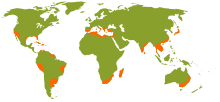- Citrus production
-
Citrus fruits are the highest value fruit crop in terms of international trade. There are two main markets for citrus fruit:
- the fresh fruit market
- the processed citrus fruits market (mainly orange juice)
Most citrus production is accounted for by oranges, but significant quantities of grapefruits, pomeloes, lemons and limes are also grown.
Contents
History
While the origin of citrus fruits cannot be precisely identified, researchers believe they began to appear in southeast Asia at least 4000BC. From there, they slowly spread to northern Africa, mainly through migration and trade. During the period of the Roman Empire demand by higher-ranking members of society, along with increased trade, allowed the fruits to spread to southern Europe. Citrus fruits spread throughout Europe during the Middle Ages, and were then brought to the Americas by Spanish explorers. Worldwide trade in citrus fruits didn't appear until the 19th century and trade in orange juice developed as late as 1940.[1]
Volume
Total production and consumption of citrus fruit has grown strongly since the 1980s. Current annual worldwide citrus production is estimated at over 105 million tons, with more than half of this being oranges. According to the United Nations Conference on Trade and Development (UNCTAD), the rise in citrus production is mainly due to the increase in cultivation areas, improvements in transportation and packaging, rising incomes and consumer preference for healthy foods.
This trend is projected to change from 2000 to 2010 since the high production levels have slowed the rate of new plantings.[1]
Countries involved
Citrus fruits are produced all over the world. According to UNCTAD, in 2004 there were 140 citrus producing countries. Around 70% of the world's total citrus production is grown in the Northern Hemisphere, in particular countries around the Mediterranean and the United States, although Brazil is also one of the largest citrus producers.
In the United States, citrus fruits for consumption as fresh fruit are mainly grown in California, Arizona and Texas, while most orange juice and grapefruit is produced in Florida.[2]
China could be a major player in the orange juice and processed citrus markets, except for high tariffs on citrus that make domestic sale more profitable. Though citrus originated in southeast Asia, current citrus production is low due to lower than average yields, high production and marketing costs and problems with disease.[3]
Citrus production in most of Europe continues to decline, although the clementines produced by Spain are increasing in popularity among consumers.[4]
Top ten total citrus fruits producers 2007 (tonnes)
World's top producer in each category is given in greyCountry Grapefruit Lemons and limes Oranges Tangerines, etc.[5] Other Total  Brazil
Brazil72,000 1,060,000 18,279,309 1,271,000 - 20,682,309  China
China547,000 745,100 2,865,000 14,152,000 1,308,000 19,617,100  United States
United States1,580,000 722,000 7,357,000 328,000 30,000 10,017,000  Mexico
Mexico390,000 1,880,000 4,160,000 355,000 66,000 6,851,000  India
India178,000 2,060,000 3,900,000 - 148,000 6,286,000  Spain
Spain35,000 880,000 2,691,400 2,080,700 16,500 5,703,600  Iran
Iran54,000 615,000 2,300,000 702,000 68,000 3,739,000  Italy
Italy7,000 546,584 2,293,466 702,732 30,000 3,579,782  Nigeria
Nigeria- - - - 3,325,000 3,325,000  Turkey
Turkey181,923 706,652 1,472,454 738,786 2,599 3,102,414 World 5,061,023 13,032,388 63,906,064 26,513,986 7,137,084 115,650,545 Source: Food And Agricultural Organization of United Nations: Economic And Social Department: The Statistical Division Oranges and orange juice
About a third of citrus fruit production goes for processing: more than 80% of this is for orange juice production. Demand for fresh and processed oranges continues to rise in excess of production, especially in developed countries.
The two main players are Florida in the United States and São Paulo in Brazil. Production of orange juice between these two makes up roughly 85 percent of the world market. Brazil exports 99 percent of its production, while 90 percent of Florida’s production is consumed in the US.[2]
Orange juice is traded internationally in the form of frozen concentrated orange juice to reduce the volume used, so that storage and transportation costs are lower.[4]
Citrus canker
Citrus production is often cut short in many areas by outbreaks of bacteria known as Xanthomonas axonopodis, or Citrus canker, which cause unsightly lesions on all parts of the plant, affecting tree vitality and early drop of fruit. While not harmful to human consumption, the fruit becomes too unsightly to be sold, and entire orchards are often destroyed to protect the outbreak from spreading.[6]
Citrus canker affects all varieties of citrus trees, and recent outbreaks in Australia, Brazil and the United States have slowed citrus production in parts of those countries.
References
- ^ a b H. John Webber (1967). History and Development of the Citrus Industry. University of California Division of Agricultural Sciences. http://lib.ucr.edu/agnic/webber/.
- ^ a b USDA Foreign Agricultural Service. "USDA - U.S and the World Situation: Citrus" (pdf). http://www.fas.usda.gov/htp/horticulture/citrus/2004%20Citrus.pdf.
- ^ Cheju Citrus Research Institute, Korea. "Citrus Production in Asia". Asian Studies on the Pacific Coast. Archived from the original on 2006-10-07. http://web.archive.org/web/20061007163603/http://www.agnet.org/library/article/ac1996c.html.
- ^ a b Thomas H. Spreen. Projections of World Production and Consumption of Citrus to 2010. http://www.fao.org/documents/show_cdr.asp?url_file=/DOCREP/003/X6732E/x6732e02.htm.
- ^ Includes tangerines, mandarins, and clementines.
- ^ Gottwald, T.R, Graham, J.H. and Schubert, J.S. (2002). Citrus canker: The pathogen and its impact. Online. Plant Health Progress doi:10.1094/PHP-2002-0812-01-RV
External links
Lists of countries by agricultural output rankings Cereals Fruit Vegetables Other Cacao · Cassava · Coffee · Fish · Garlic · Milk · Sugar beet · Sugar cane · Sunflower seed · Tea · Tobacco · WineRelated Categories:- Citrus
- Orange production
- Horticulture and gardening
Wikimedia Foundation. 2010.


